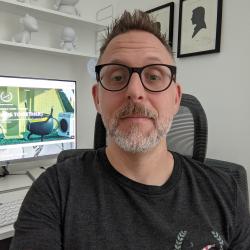What do you think happens when we die? I’m aware that’s an existential question to open a review of a short with, but it’s a pertinent question considering the film I’m about to discuss. Most belief systems envision some form of “self” still existing after death, but where it goes depends very much on the individual religion. Barbara Rupik’s nine-minute short combines textural stop-motion with a haunting narrative to follow the journey of one such soul. Tackling themes of spirituality and decay. DUSZYCZKA (The Little Soul) is one of the boldest and most memorable shorts I’ve seen in 2021.
Opening on a muddy riverbank, the sounds of the flowing water blending hauntingly with the short’s unusual score, we’re introduced to DUSZYCZKA’s titular protagonist as it exits a rotting corpse on the murky shore. As this lonesome being wanders the woods in which it now finds itself, it encounters various other souls, including that of a horse – which it befriends. Together they journey through a spiritual world until their paths diverge, one following the conventional path, the other travelling a more unexpected route.

The tiny soul departs the deceased and enters into a world of fellow beings.
Although I’m not a religious man myself, recent events have certainly made me more aware of the fragility of life and DUSZYCZKA paints a provocative view of the “afterlife” and the idea of the soul. Depictions of the soul tend to be ethereal figures, dainty and weightless, but Rupik’s portrayal feels much more grounded in reality, her being wallowing in mud instead of floating through the air. It’s this tangible quality that helps lend weight (probably around 21 grams) to the story and though authenticity isn’t exactly key to the success of a film like this, the narrative and aesthetic approach here certainly helps its audience immerse itself in this unusual universe.
Described by Rupik as an “animated assemblage”, the filmmaker employs a number of different materials and techniques to bring her story to the screen and they combine to create a glorious and often gory aesthetic. Managing to be both beautiful and grotesque in equal measure, the palpable nature of the visuals bring bile to the back of your throat and admiration to the front of the mind. You can clearly see the director’s inspiration here – she cites Giovanni Canavesio medieval painting The Suicide of Judas as the main motivation behind her story – but Rupik’s film never feels derivative. Her inspiration may date back over 500-years, and the short’s themes even further than that, but this is a contemporary piece from a filmmaker obviously interested in pushing boundaries and honing her voice.
The first line on our About page declares that “short film is where innovative storytelling is born” – a statement I’ve long believed to be the case and one that informs much of the work I do with S/W. DUSZYCZKA is a prime example of this belief and it sounds as if Rupik’s perspective on short film is very similar to ours. As she explains in this conversation at the Clermont-Ferrand International Short Film Festival: “The short format gives the freedom to be more expressive and the possibility to experiment with the narration and visual aspects of the film. It is much easier to take a risk and turn even the weirdest and obscurest idea into a picture. Making short films is the best way to find your own characteristic film language. I hope I have the same freedom if the opportunity to make my first feature-length film occurs”.
I couldn’t have put it better myself. Fingers crossed we’ll get to see that feature someday.

 Rob Munday
Rob Munday